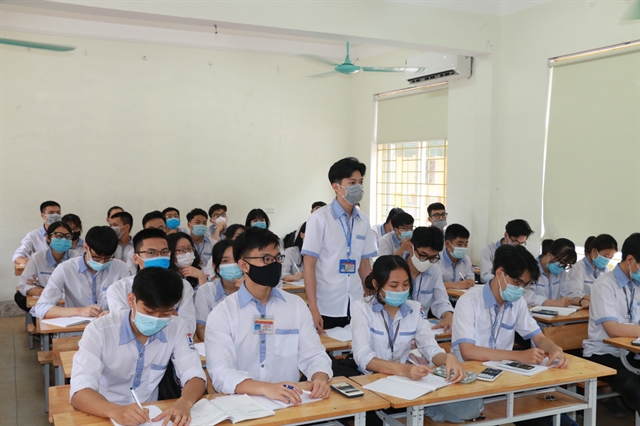
HÀ NỘI — Great progress has been observed in illiteracy eradication and education universalisation in Việt Nam, as the country continues building a learning society.
Illiteracy eradication and education universalisation are major policies of the Party and State, aiming to improve people’s knowledge, train human resources, foster the development of talents and contribute to the successful implementation of industrialisation and modernisation targets of the country.
According to UNESCO, “literacy is the ability to identify, understand, interpret, create, communicate and compute, using printed and written materials associated with varying contexts.” Conversely, illiteracy is understood as the state of people who cannot read or write.
In most developing countries, the low quality of basic education leads to a high number of illiterate persons. Illiteracy is associated with social challenges such as poverty, gender and income inequality.
Literacy eradication is a smart investment for the future and the first stage for all new forms of education universalisation in the 21st century.
In 1965, UNESCO selected September 8 every year as the International Day for the Elimination of Illiteracy, with the aim of highlighting the importance of education universalisation for citizens, communities and society as a whole. The organisation has actively lobbied the international community and promoted illiteracy eradication as a tool to empower individuals, communities, and societies.
In Việt Nam, President Hồ Chí Minh was the one to have launched a campaign to end illiteracy once the country achieved independence in the 1940s. He considered illiteracy a national problem and “ignorance” a dangerous enemy that must be eliminated.
It was around this time 76 years ago that saw the beginning of a popular movement known as “Bình dân học vụ” (Mass Education Movement), which was initiated by the late President.
It encouraged people of all ages to volunteer to teach others to read and write, and basically helped eradicate illiteracy in the country.
A year after launching, more than 2.5 million people escaped from illiteracy. This is a feat of socialisation in the educational history of Việt Nam.
The practical experience of illiteracy eradication in the North became valuable and useful lessons for the illiteracy eradication work in the South right after the liberation and reunification of the country. By the end of February 1978, all 21 southern provinces and cities had basically eliminated illiteracy.
The cause of raising people’s intellectual level advanced to a new level in the 1990-2000 period, when the whole country implemented the illiteracy eradication-primary education universalisation, in order to realise the goal of entering the 21st century without illiteracy as recommended by UNESCO and launched by the United Nations.
In the next 10 years, Việt Nam continued to universalise the secondary education scheme, which was completed in 2010.
Despite being a developing country with many difficulties, Việt Nam was always highly valued by international organisations for its achievements in education and education universalisation. Since 2014, the Government has issued many policies to promote education universalisation and illiteracy eradication, especially those for ethnic minority-inhabited areas.
Việt Nam has made important achievements in education development. All the provinces and cities have fulfilled the target of universalising preschool education for five-year-old children, met the standard of primary education universalisation at level 2 and secondary education universalisation at level 1.
All 63 provinces and cities of the country have met illiteracy eradication standards at level 1. Literacy classes have been organised for more than 300,000 people aged 15-60 nationwide.
Thanks to the project on building a learning society from 2012-2020, the network of educational establishments were expanded nationwide.
There are also more than 10,000 community-based learning centres across the country.
Educational institutions have promoted online learning and teaching, teaching on television, and have gradually developed mass open online courses.
In the next phase from 2021-2030, the project aims to help Việt Nam develop an open, flexible and connected education system and make sure all people will have an equal opportunity to access high-quality life-long education.
According to statistics, over 53,000 schools nationwide have organised online teaching and learning, raising the average rate of students participating in online learning to 80 per cent. The number of people joining classes to update knowledge, skills, technology transfer; classes of foreign languages, applied informatics, life skills education, short-term vocational training at community learning centres has also increased.
According to Vice Chairman of the Việt Nam Association of Promoting Education Phạm Tất Đồng, the project has helped form a learning society model at the commune level.
Minister of Education and Training Nguyễn Kim Sơn has underlined the need to clearly define the role of elements and parties involved in learning society development in the coming time.
Individuals must be supported, motivated, and recognised in academic development, while educational institutions and businesses must play a pivotal role in this scheme, he said.
The ministry would review and evaluate the effectiveness of the operation model of continuing education centres and community learning centres, he noted.
Attention would be paid to speeding up illiteracy eradication, developing remote training systems, promoting communication activities, and increasing digital data sources serving regular learning, the minister added. — VnExpress News
- Reduce Hair Loss with PURA D’OR Gold Label Shampoo
- Castor Oil Has Made a “Huge” Difference With Hair and Brow Growth
- Excessive hair loss in men: Signs of illness that cannot be subjective
- Dịch Vụ SEO Website ở Los Angeles, CA: đưa trang web doanh nghiệp bạn lên top Google
- Nails Salon Sierra Madre
 VnExpress News The News Gateway of Vietnam
VnExpress News The News Gateway of Vietnam





